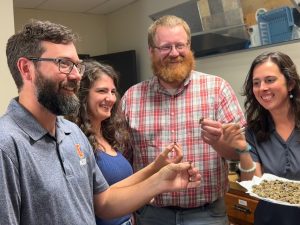Cicadas on your ice cream? Pizza? It doesn’t bug some
By Jenna Braasch Illinois Extension — June 12, 2024
Many people enjoyed the vanilla ice cream sundae with strawberries, chocolate, and topped with roasted cicadas. (Photo by Matt Wiley/Illinois Extension)
URBANA, Ill. — “That’s surprisingly delicious!” This is maybe not the phrase first expected to be heard when trying a once-in-a-lifetime lunch menu of cicada pesto pizza, cicada tempura bites with lime aioli, and, for dessert, cicada ice cream sundaes.
This spring, a team of University of Illinois Extension educators fully embraced the historical double-emergence of cicada broods a little out of the box and closer to the plate.
When Ken Johnson and Chris Enroth, Good Growing podcast hosts, and Extension horticulture educators, started working on a periodical cicada episode, they wanted to explore every angle from science to nutrition. So they recruited entomologist Kacie Athey, assistant professor and Extension specialist in the College of Agricultural, Consumer and Environmental Sciences, and then Kristin Bogdonas, Extension nutrition and wellness educator, as lead chef.
Extension staff, Master Gardeners, Master Naturalists, and community members were then invited to sample a cicada-themed lunch in late May during the peak of the cicada emergence in Springfield.
Eating Cicadas
Wildlife aren’t the only things that can eat cicadas; humans can too. Historically, Native Americans

Extension’s Team Cicada members Ken Johnson, Chris Enroth, Kristin Bogdonas and Kacie Athey try a roasted periodical cicada together. (Photo by Matt Wiley/Illinois Extension)
used them in their diet.
“Outside of Western culture, eating insects is less of a novelty, part of a regular diet, and often found as a popular street food choice,” says Johnson.
Be sure to speak with an allergist before enjoying cicadas for those with shrimp or shellfish allergies since they are related. Cicadas should be treated as any other potential allergen when preparing food. Like other edible insects, cicadas are low in fat, a good source of protein, and contain a variety of vitamins and minerals.
To prepare for the culinary curiosity cicada lunch, Johnson collected newly emerged Brood 13 cicadas from maple trees in his backyard and froze them days before recipe testing. At this life stage, the cicadas are white and soft-bodied with soft wings. When collecting cicadas, it’s important to know the tree and lawn care practices used at the site. Do not collect from areas treated with pesticides or unknown soil types due to higher levels of metals found in some soils.
On event day, the kitchen was buzzing. The team quickly found out that after thawing the cicadas followed by blanching them, it filled the room with the smell of cooked asparagus.
When the moment for the taste test arrived, the team counted one, two, and three before they each popped a roasted cicada in their mouth with a laugh. They all smiled in shock. “It’s actually delicious and tastes just like a vegetable,” said Bogdonas.
Sampling Cicadas

Pizza with extra toppings, including periodical cicadas. (Photo by Matt Wiley/Illinois Extension)
Soon, the room began to fill with curious guests. Some were eager to try, while a few had reservations and hesitated to make a plate. Team Cicada, as some refer to them, led a discussion on periodical cicadas and answered questions about the historical emergence and nutritional values.
The room quickly filled with conversation, laughter, and, for many, a new experience they genuinely enjoyed. The top-voted dish of the day was the fried tempura cicadas, followed by pizza, ice cream, and plain roasted cicadas. Numerous people shared that the chopped cicadas on top of the ice cream smelled like almonds. One person asked for seconds, and many took home samples for their family and friends to try. Several people made sure to give their compliments to the chef.
Relive the day with the Good Growing Podcast Episode 175: Eating Periodical Cicadas, available at go.illinois.edu/EatingCicadas. The page also contains a link to watch the video version with featured cooking and tasting reactions. Find cicada recipes at go.illinois.edu/CicadaRecipes.
Subscribe to the Good Growing blog for weekly horticulture topics, podcast episodes, and more at go.illinois.edu/GoodGrowingSubscribe.
Illinois Extension leads public outreach for University of Illinois by translating research into action plans that allow Illinois families, businesses, and community leaders to solve problems, make informed decisions, and adapt to changes and opportunities. Illinois Extension is part of the University of Illinois Urbana-Champaign College of Agricultural, Consumer and Environmental Sciences.







